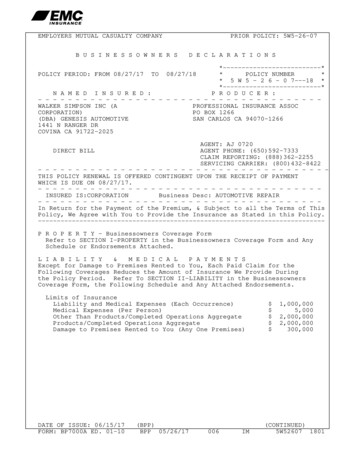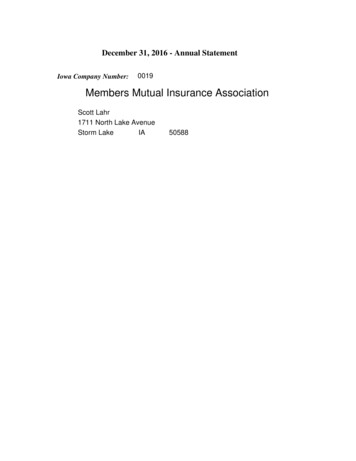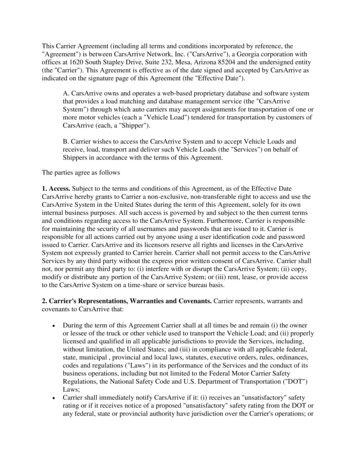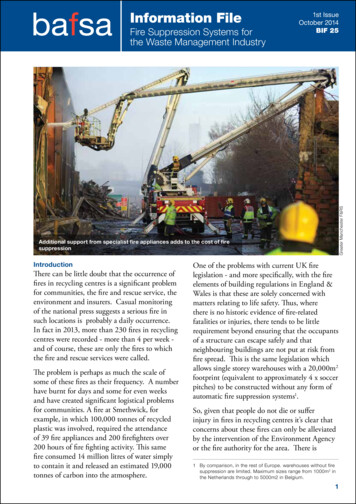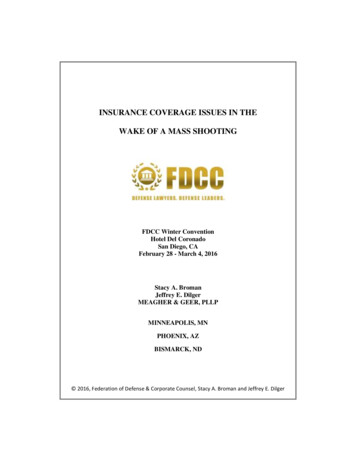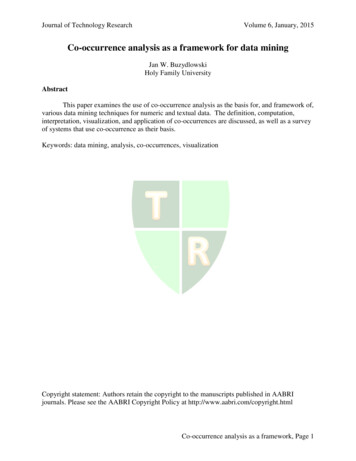
Transcription
Journal of Technology ResearchVolume 6, January, 2015Co-occurrence analysis as a framework for data miningJan W. BuzydlowskiHoly Family UniversityAbstractThis paper examines the use of co-occurrence analysis as the basis for, and framework of,various data mining techniques for numeric and textual data. The definition, computation,interpretation, visualization, and application of co-occurrences are discussed, as well as a surveyof systems that use co-occurrence as their basis.Keywords: data mining, analysis, co-occurrences, visualizationCopyright statement: Authors retain the copyright to the manuscripts published in AABRIjournals. Please see the AABRI Copyright Policy at http://www.aabri.com/copyright.htmlCo-occurrence analysis as a framework, Page 1
Journal of Technology ResearchVolume 6, January, 2015INTRODUCTIONData mining is the automated exploration of data, textual or numeric, to determine rules,patterns, information, or anomalies that are unknown within a dataset. There are manymethodologies that are classified as data mining, but one method that this paper will focus uponis the use of co-occurrence analysis for the extraction and display of the rules and patterns withindata, both numeric and textual. More to the point, this paper will explore co-occurrence analysisas a framework for multiple data mining techniques.Co-occurrence analysis is simply the counting of paired data within a collection unit. Forexample, buying shampoo and a brush at a drug store is an example of co-occurrence. Here thedata is the brush and the shampoo, and the collection unit is the particular transaction. In thisexample, the paired data is {shampoo, brush} and it occurs once. Of course, more items can bepurchased at a time, so the pairings become more numerous as each item is paired with eachother item. For example, if in addition to the two items, a third item is purchased, say, goo, thenthere are three pairings ({shampoo, brush}, {shampoo, goo}, {brush, goo}), again each with acount of one.The collection unit and the data therein can be varied. For example, it can be a shoppingcart, with the purchased items as the data, as in the example; a questionnaire, with the responsesto the questions as the elements; or a paper’s bibliography, with each cited author as the focus ofthe analysis.The combination of all of the collection units then forms the support for the analysis.The support may be the purchases of a particular store for a particular day, all the questionnairesreturned, or a digital library of a particular journal.For example, if 100 three-question surveys were filled out and returned as a response toan email request, then there would be 100 collection units, each containing the data for eachrespondent, all of them forming the support of the analysis. Again, the data is analyzed pairwise, so if Respondent 1 answered “A” to Item 1, “B” to Item 2, and “C” to Item 3, then the dataanalyzed would be ({1:A, 2:B}, {1:A, 3:C}, {2:B, 3:C}). Similarly, if Respondent 2 alsoanswered “A” to Item 1, “B” to Item 2, but “A” to Item 3, the data analyzed would be ({1:A,2:B}, {1:A, 3:A}, {2:B, 3:A}). Both are combined and the support would be: ({1:A, 2:B},{1:A, 3:C}, {2:B, 3:C}, ({1:A, 2:B}, {1:A, 3:A}, {2:B, 3:A}). This would be done for theremaining 98 respondents.When items co-occur, there is an association between them by the gathering agent, e.g., ashopper, a survey participant, or an author of a journal paper citing works to support their ownwork. If a pairing is done only once in the support, the association is tenuous or spurious. If thepairing is done by many gathering agents, then the association is made stronger with eachadditional pairing.In the previous example, for the two respondents mentioned, both responded {1:A, 2:B}.If only two answered in this way, there seems to be little association. However, if the other 98respondents answered {{1:B, 2:A} , then there is an extremely strong relationship betweenAnswer B for Item 1 and Answer A for Item 2. Furthering this example by supplying meaningto the questions and responses, if Item 1 was gender, where “A” meant “male” and “B” meant“female,” and Item 2 corresponded to satisfaction (“A”) or dissatisfaction (“B”), then, whilethere is a small cadre of mad males, there is a large pool of satisfied female respondents.As another example, one which uses Author Co-citation Analysis (discussed later), if anauthor cites works by Plato and Woody Allen, and that co-occurrence appears only once withinCo-occurrence analysis as a framework, Page 2
Journal of Technology ResearchVolume 6, January, 2015one paper within a large digital library, then those authors are related, but only within the mindof the one citing author. If however, Plato and Aristotle are cited thousands of times within thatdigital library, then it is can be inferred that those authors are highly related. It is important tonote that in this example it is known to the casual reader that those associations between thosetwo philosophers hold through prior knowledge; however, the co-occurrence analysis will showthis to be true both of authors that are known, as well as unknown, i.e., mined associations.Moreover, the items need not be authors, but any two co-occurring elements, perhaps, moviesthat one views on a streaming video service. Some viewers have eclectic and varied tastes, sosome parings will be rare, but others are more mainstream and some parings will be common andnumerous. For example, few—if any—may have watched both “The Ditch Digger’s Daughter”and “Jackass Number Two,” but many have watched “Godfather” and “Godfather II.” Again,this is a theorized association, but the analysis of the data would most likely bear this out andmakes sense intuitively.Finally, the items of interest need to be determined, either a priori, or suggested by thedata, before the analysis can be done. It would become both overwhelming and insignificant, toexplore all pairings done by all entities within a collection. For example, to analyze all itemspurchased at a drug store by all the customers on a particular day would yield too many pairingsupported by too few data. This is because the number of pairings examined growsgeometrically, while the occurrence of all possible pairings is sparse. The examination of only100 items yields 4,950 possible pairings, some of which are never purchased together by anyone,e.g., goo and hair growth tonic. (The derivation of the numbers of pairings will be discussedbelow). It might be of interest, then, to explore just the top-five-selling items one day, or to lookat only purchases involving toothbrushes to keep the number of pairings reasonable and wellsupported by purchases. The last example of items associated with a toothbrush is a seed termand then use it to find other n values that co-occur with that seed; this is explored in a latersection.It is then through the examination of all the pairings of the items of interest, within acollection unit, by the gathering agents, in a support of analysis collection that patterns emergewhere they then can be visualized and gleaned.DERIVATION AND REPRESENTATION OF CO-OCCURRENCESFor the purposes of this section, a small example of specific data will be examined toshow how the raw counts and/or the statistics are derived to form the basis of co-occurrenceanalysis. To that end, then, consider the following data:[{A, B}, {A, B, C}, {A, D}, {B, C}]Each set of data between the braces indicates the collection unit of analysis and thecombination (four) of them all is the support of analysis, i.e., between the brackets. The items ofinterest will be A, B, C, and D.The letters A though D could represent items purchased in a supermarket, so thecustomer, for the first set, purchased Items A and B. A second customer purchased A, B, and C.And, so on. The letters could also represent movies that four customers have viewed in the lastweek. The letters could also represent the key terms used to classify four papers, noun phraseswithin their abstracts, or cited authors (or journals) in their respective bibliography sections. It isleft to the reader to generate another possible scenario which the sample data represents. What isCo-occurrence analysis as a framework, Page 3
Journal of Technology ResearchVolume 6, January, 2015important is to recognize that this form of data is widely available and that this paper’s purposeis to show the different ways in which it can be analyzed and mined.Once the items and collection are defined, the co-occurrence counts can then be derived.This is usually represented by a co-occurrence matrix, with the items of interest forming the rowand column headings and the intersection of the row and column (cell) indicating the cooccurrence. Given our above example, then, the following matrix would be as shown in Figure 1(Appendix).In this representation, the values on the main diagonal are values representing thefrequency of occurrence of an item within a collection. In our example, “A” occurred threetimes, as did “B.” And so on. (Those cells allow the computation of some statistics, such asBayesian probabilities, of the other values in a row, e.g., P (B A) 2/3.)The reader will also notice that the matrix is symmetric, i.e., the value of Cell (A, B) 2is also the value of Cell (B, A) 2, as co-occurrence, according to our definition, iscommutative. If the interpretation of the co-occurrence, though, is given another meaning, say,temporal, i.e., {A, B} means that A was obtained first, then the matrix would not necessarily besymmetric.Taking all of the values, the number of data points is N * N. However, many of themethods used to analyze co-occurrence matrices assume a symmetric matrix, as well as givingno meaning (significance or use) to the values of the main diagonal. Given this interpretation,suppression of the main diagonal values and a symmetric matrix, the number of unique cooccurring pairs is (N * (N - 1))/2, given N representing the number of items of interest. This,then, illustrates the computation of the example in the previous section of 4,950 pairings given100 items of interest ( (100 * 99)/2), and how too many items under consideration soon becomeunwieldy, even given these restrictions of symmetry, etc. In our example there are six pair-wisedata in the matrix we are considering under those two assumptions with four items of interest, asshown in Figure 2 (Appendix).INTERPRETATION OF CO-OCCURRENCESOnce the counts are determined, then the matrix can be analyzed. It is of interest toexplore the different, sometimes dual, nature of those values and how they can be interpreted.The values so far have been interpreted as similarities, e.g., Cell (A, B) 2 indicates thatA and B are somehow related by a measure of 2, and a number of techniques use thisinterpretation. In this case, the higher the value, the more similar the items are. However, if theinterpretation of the value is that of dissimilarity, then the matrix can be thought of as a distancematrix, similar to a driving map showing the distance between cities on a map. For example,suppose that Cell (A, B) 2 indicates that elements A and B, say, cities, are, say, two miles,apart. Here, the larger the value the more distance the two elements are. The elements on themain diagonal then would need to be zero, as the distance between the same city necessarilyneeds to be zero and the matrix would be assumed symmetric. However, this paper will focusupon the values in the matrix to be that of similarity, although transformations exist forconverting dissimilarity matrices to similarity matrices. This is discussed later.Next, if instead of viewing the individual values, the rows or columns are instead focusedupon, then other interpretations, and thus other methodologies applied, are also possible. Forexample, if the rows of a full matrix with N columns are interpreted to be a vector in N-space,then those rows represent points in that space. For example, given the full matrix example in theCo-occurrence analysis as a framework, Page 4
Journal of Technology ResearchVolume 6, January, 2015previous section, Point A would be (3, 2, 1, 1), Point B would be (2, 3, 2, 0), etc., in 4-Space.Given this interpretation, some techniques, e.g., self-organizing maps, a special case of neuralnetworks, can be applied, which will be discussed later.Another interpretation exists if the columns are defined to be responses associated withthat column heading, then correlations can be calculated, say using Pearson’s rho, between thecolumns. Using the calculated correlations, another matrix can be formed such that the cellsrepresent the, say, Pearson correlation between the two rows, i.e., Cell A, B would contain thecorrelative measure between the column values of Row A and Row B. Cell A, C would be thecorrelation of Rows A and C. And so on. The values of the main diagonal would be one,because the correlation with a row with itself would be one, and the matrix would be symmetricbecause the correlation with, say, Rows A and C are the same as with Rows C and A. Othercorrelative or similarity measures also exist and can be applied, and these, along with somecaveats as to their application, as well as dissimilarity measures, are discussed in (Leydesdorff,2006).Finally, if the values are interpreted as simply indicating a connection between the twovalues, ignoring the magnitude of the value, and instead replacing the value with a 1, if theoriginal value is equal or greater than one, or 0, if the value is zero, then this becomes anadjacency matrix. For example, given our previous example, the matrix becomes, as in Figure 3(Appendix).Here, it is only the connection that is of interest, and the matrix can be interpreted to thatrepresenting a network, with the elements as nodes and the connections as links, where a numberof techniques can be applied to analyze the data, e.g., see (Sedgewick, 1988). (Nonetheless, thevalue of the co-occurrences can be replaced to show the strengths of the links.) Moreover, thisforms the basis of finding elements not directly related (co-occurring), but that are relatedthrough intermediate elements. Given this interpretation, social network analysis techniques,forming the basis of many new social media applications, is certainly applicable. Theapplication of co-occurrence as a social network is discussed in (Leydesdorff, 2006). Anotherinterpretation of indirect connections, co-occurrence chains, will be discussed later.VISUALIZING CO-OCCURRENCE MATRICESThere are three popular ways to visually express the data of a co-occurrence matrix. They are:multi-dimensional scaling (MDS), Pathfinder networks (PFNETs), and self-organizing, or Kohonen,maps (SOMs). The format of MDS seems to be subsumed by both SOMs and PFNETs and so this paperwill focus on the latter two. A reader interested in exploring MDS is referred to (Kruskal, 1978).An n-by-n co-occurrence matrix can be viewed as both an adjacency matrix of a network with nnodes, or as a set of n vectors in n-space. As a network, a PFNET is used to render it visually(Schvaneveldt, 1990). As a vector in n-space, a SOM is used (Ritter, 1989). This section will brieflydescribe both.A network consists of nodes and edges. In a co-occurrence matrix, the names themselvesrepresent the nodes and the co-occurrence values represent the edge weights. For instance, given asimple 3 x 3 matrix in Figure 4(Appendix), a corresponding network representation is shown in Figure 5(Appendix).In order to keep this example simple only three nodes are used and thus contain only three edges(or links). However, in larger networks the visual complexity overwhelms the viewer and presents noadvantage over the simple raw co-occurrence matrix. As mentioned, a network of 25 items (nodes) hasCo-occurrence analysis as a framework, Page 5
Journal of Technology ResearchVolume 6, January, 2015300 edges (values). A PFNET is used to remove some of the redundant or less-salient links to show amore understandable network.A PFNET is created by examining each link between each node pair. Alternate paths around thetwo nodes are examined to see if there is a shorter path. If there is, then the link between the two nodesis eliminated. The walk length, q, of the alternate path (i.e., how many links to examine) and the metricused to measure the distance of the alternate path, r, (e.g., city-block distance, Euclidean distance, ormaximum link length) are specified by the user. For this example, we use q n-1 and r maximum linklength as this reveals a network with the fewest links.A PFNET based on Figure 5 is shown in Figure 6 (Appendix). In this example, the link betweenSmith and Jones (weight of 2) is not removed as the maximum weight of the alternate path, Smith –Brown – Jones is 5, which is greater than 2. However, the link between Jones and Brown (weight of 5)is removed as the maximum weight of the alternate path, Brown – Smith – Jones, is 3, which is less than5.The reasoning for the removal of the link is that Jones is better related to Brown through theassociation of Smith rather than directly. Thus in our example the network with three links is reduced totwo. In large networks, this reduction results in readily interpretable networks. The reader is referred to(Schvaneveldt, 1990) for a more thorough discussion of PFNETs and their application.If the rows of a co-occurrence matrix are viewed as n vectors in n-space, then a special type ofneural network, a self-training network, can be used to arrange, or reduce, the n-space to a lowerdimension, in this case, two dimensions.In a traditional neural network, the categories associated with an entity are known and theexisting data is used to train the system to recognize new instances and place them in those categories.However, with the co-occurrence matrix it is the categories themselves which are sought and a selforganizing, or self-training, network is used to find categories by examining the data within the cooccurrence matrix.A SOM is based on a two-dimensional grid of evenly spaced nodes. Figure 7 (Appendix) showsa network consisting of 4-by-5 nodes. (Please note that the use of network here is different from theprevious discussion of PFNETs. For PFNETs, the network model is based on a mathematical definition,whereas for SOMs the network refers only to the grid of nodes.)It is important to note that each node corresponds to a vector of values. In our example, withthree names each vector would consist of three ordered values, e.g. (2, 3, 4). Each row of the cooccurrence matrix also represents a three-valued vector.To train a SOM, the network of nodes are initialized to random values. Then, a row of the cooccurrence matrix is chosen at random and compared to each node. The node in the grid with the closestEuclidean distance to the row is determined. The values of the node chosen are modified to reduce thedistance between itself and the row. Also, the nodes surrounding the chosen node are similarly adjusted.Then, another vector (row) is randomly chosen (the selection is with replacement so each vector can bereselected), and the process repeats many times.The resulting network consists of nodes containing values corresponding to categories within theco-occurrence matrix. These categories are delineated by areas of nodes in which the element with thehighest value of the vectors are the same. For example, if the second element of the vectors in theupper-right hand corner of a network are the same, then they would be considered an concept area. Thearea then would be labeled by the second row name, in our case, Brown, corresponding with the nodewith the highest of all the second value. Figure 8 (Appendix) shows this concept.The finished networks reveal an arraignment of terms that reflect the categories inherent in theco-occurrence matrix and do so in a very concise way.Co-occurrence analysis as a framework, Page 6
Journal of Technology ResearchVolume 6, January, 2015A reader interested in the further studying SOMs and their application of co-occurrence analysisis referred to (Doszkocs, 1990).FINDING THE ITEMS OF INTEREST AND SUPPORTAs previously discussed, the more items to explore within the area of support, the moreco-occurrences there are, and they grow geometrically. For the aforementioned probleminvolving 25 names, there are 300 co-occurrences. Moreover, there is a limit on the support thatis available for each co-occurrence, as some might not co-occur at all, as well as there is a visuallimit as to the number of elements that the analyst’s eye can consider. For that reason, there aretwo major ways to determine and limit the items considered.One method is to use an external resource to determine which items are of interest. If onewas using Author Co-citation Analysis to explore the groupings of specific authors within acertain discipline, then one could research which authors were of interest and use those. Say toexplore the top ten authors in bibliometrics, this would be possibly determined by their citationcounts. The top ten authors within bibliometrics that are cited most often by other authors wouldbe chosen. Or, if exploring the relationships between movies, then those that were nominated foran Academy Award for a particular year may be the items of interest. In this last case, however,it is important to note that, while the items of interest are defined, the movies, the support ofanalysis is not, from where the data is to be extracted. That is to say, what database will be usedto find the co-occurrences of the selected movies? Where the data are to be extracted is also ofimportance; so, both the items to be considered as well as the database used to calculate the cooccurrence are important.For example, every movie that is viewed by someone over the course of their NetFlixsubscription can be viewed as a collection unit, and the collection of all customers withinNetFlix’ database would be the support of analysis. The movie rental data from Redbox couldalso be considered as an alternative, as well as the purchased movies within Amazon. It can beimagined that the patterns of co-occurrence may be different between these three data sourcesbased on convenience, demographics, and purchasing/rental patterns, and the results of theanalysis may be different, as well.Finally, when people buy or consume items, their collective behavior can be consideredas a collection unit. When someone is interested in a “more like this” scenario when they haveseen a good movie (or read a good book), it would be easy to simply explore the database byfinding people who also viewed that particular movie and then, within that set, find the secondmost-often (co-) occurring movie (or book). It could then be done for any number of additionalmovies, then, say find the 25 most frequently occurring movies, rank ordered by frequency of cooccurrence. This is the use of the aforementioned concept of finding the items of interest, that ofusing a seed term.APPLICATION OF CO-OCCURRENCESAs mentioned in the beginning of this paper, data mining is the automated exploration ofdata, textual or numeric, to determine rules, patterns, information, or anomalies that are unknownwithin a dataset. A number of fields have used co-occurrence analysis to mine data that is withinits purview, and three major areas will be highlighted here: bibliometrics, shopping cart analysis,and associative connections.Co-occurrence analysis as a framework, Page 7
Journal of Technology ResearchVolume 6, January, 2015Bibliometrics is the study of statistical and mathematical techniques applied to theanalysis of text and documents. While there are many methods to explore and analyzedocuments, to keep to the purpose of this paper, co-occurrence will be the primary method toexplore.The first thing to examine is the collection unit, as well as the data items. If thecollection unit is the title of a paper, then the data of interest may be the nouns and noun phrases.For example, for this paper, the collection unit, the title, using nouns and noun phrases, wouldyield {co-occurrence-analysis, framework, data-mining}. Another unit of collection is the keyterms used to categorize a paper. For example, again for this paper, they are {data mining,analysis, co-occurrences, visualization}. A third popular unit of collection is the cited authors orcited works of a paper. Looking at this paper, one could build a collection unit of the firstauthors in the Bibliography Section {Balachandran, Buzydlowski, Doszkocs, etc.}. This lastapplication is known as Author Co-Citation Analysis (ACA) and is well researched area (White,1981) (White, 1990).Author Co-citation Analysis looks at visualization of maps created by the analysis of thecollection of co-citation patterns by authors within a particular index or database. The analyst isinterested in the groupings and connections that form within the maps.The analysis starts with the specification of the authors of interest. They could be authorsof interest to the analyst, although a single name seed could be used. The next step is to find thenumber of times each author is co-cited with each other. A visualization is then used to showhow all of the authors are related by their co-citations. What the result of such an analysis yieldsis the grouping of authors of interest by their areas of specialty and yields a map to show theirgroupings. A specific example of an ACA, as well as methods of visualization, are discussed inlater sections.A second area of the application of co-occurrence analysis is that of shopping cartanalysis.Shopping cart analysis is the example used in the introduction to the paper. Whensomeone buys shampoo and a brush, there is an association between the two. This is oftenclassified as an association rule. In this form, then, the rule would be shampoo - brush, i.e.,when someone buys shampoo, then they also buy a hairbrush. The left hand side (LHS) of therule is “shampoo.” The right hand side (RHS) of the rule is “brush.” (The converse, brush - shampoo, may or may not be true and can be determined by metrics which will be discussed.)The support of analysis is specified by the analyst, such as the week’s sales for aparticular store. The collection unit is total sale, and the data are the items purchases. What is ofinterest is to find unknown rules generated by the data. For instance, in a supermarket, the ruleof tomato-sauce - spaghetti would be expected, but spaghetti - wine may not be. If the latterwas true, it may be profitable to the store to move the wine closer to the pasta.There are statistics that are associated with association rules: support, confidence, andlift.Support is the number of records where both elements of the rule appear (co-occur)divided by the number of records. In terms of probability, it is the probability of both elements,LHS and RHS, occurring within the support of analysis [P(LHS and RHS)], or the number oftimes the RHS and LHS co-occur (divided by the number of records).Confidence is the number of records where the both left hand and right hand side of therule appears (co-occur) divided by the number of times the left hand side of the rule appears.Again, in terms of probabilities, it is conditional probability that the RHS occurs given that theCo-occurrence analysis as a framework, Page 8
Journal of Technology ResearchVolume 6, January, 2015LHS occurred [P(RHS LHS)], or the number of times the LHS and RHS co-occur divided bythe number of times the LHS occurs.Finally, lift is the confidence of the rule divided by the number of times the support ofjust the RHS [P(RHS LHS) / P(RHS)], or the number of times the LHS and RHS co-occurdivided by the number of times the RHS occurs. Lift values equal or close to one indicate noassociation between the RHS and LHS, i.e., they are independent. Values higher than oneindicate that the rule is of value. Values less than one indicate that the rule is contraindicated,i.e., the RHS occurs less often with the LHS.The application and visualization of association rules is presented in a later section.A third application of co-occurrence is the application of it to find indirectly relatedelements, i.e., exploring elements that are not directly co-occurring but are linked viaintermediate co-occurring relationships.For example, consider three cited authors: A, B, C. If A is co-cited with B, and B is cocited with C, but C is not co-cited with A, then there is also an associative—perhaps unknown—link between Authors A and C through Author B (A – B – C). The chains can be longer, such as(A – B – C – D) where the not-directly connected terms do not co-occur, but are connected byterms that are, e.g., A and D do not co-occur, but A and B do, B and C do, and C and D do.This method should also be familiar to the reader as this is the familiar “Six Degrees ofKevin Bacon” game. In this game, an actor is suggested and it is up to those involved to find themovies which involve intermediate actors which eventually connect the suggested actor to KevinBacon. A similar concept is to find an author’s Erdos Number, again, by finding authors thatwork as intermediates who co-wrote papers with the prolific mathematician, Paul Erdos. A morescholarly use of this concept is to find authors who are indirectly co-cited (Buzydlowski, 2008).This method of indirect co-occurrences has been applied to journal keywords todetermine associations previously unknown via the Arrowsmith Project (Smalheiser, 1998),where an unknown connection between an ailment and a cure was found. A system connectingco-cited authors not directly connected will be discussed in a later section.SYSTEMS FOR CO-OCCURRENCE VISUALIZATION AND MININGA system built to explore co-author citations was developed and was called AuthorMap(Buzydlowski, 2002). To use the system, the analyst merely entered the name of a single authorof interest, a name seed, and the sys
methodologies that are classified as data mining, but one method that this paper will focus upon is the use of co-occurrence analysis for the extraction and display of the rules and patterns within data, both numeric and textual. More to the point, this paper will explore co-occurrence analysis as a framework for multiple data mining techniques.

